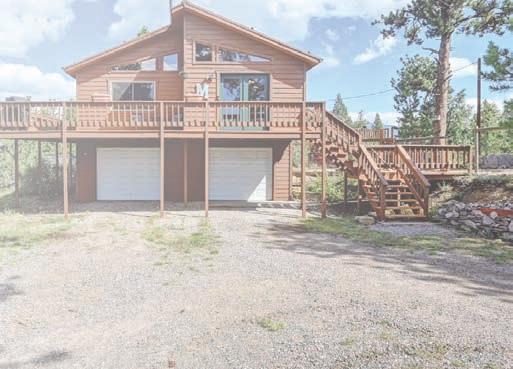
4 minute read
Will 2023 be a good year for investing?
By Brianna Gri n
The past three years have been a challenging real estate environment for home buyers and investors alike. With interest rates at record lows in the past two years and severely low inventory available, buyer demand far surpassed supply, creating an explosion in home price appreciation. These inventory shortages, not only in the housing market but across all aspects of life, led to the highest inflation seen in the U.S. since the early 1980s. In mid 2022, the Federal Reserve responded to this with the quickest and highest rate hike in history. As a result, many buyers could no longer afford the homes they were searching for due to the increased borrowing costs. Within a matter of months, the market shifted from a strong seller’s market to a more traditional market, where buyers have more negotiation power in regards to price, concessions and inspection for the first time in years! This is a natural benefit of a market shifting in the buyer’s favor.
There are many questions about what the future holds: what is the future of the economy and is a recession looming? Are we going to see another “bubble” like we did in 2008? From our perspective, the answer is no for several reasons. First and foremost, there have been much tighter lending policies adopted since 2008 to ensure buyers are well qualified to obtain a mortgage. Secondly, a majority of homeowners are sitting on a huge amount of equity due to the unprecedented appreciation that has accumulated over the past 8 years, therefore, they are better positioned to absorb a slight depreciation in values. And finally, supply is still far lower than we saw in 2008. For instance, at the end of 2022 the housing inventory in Denver and 11 surrounding counties was under 5,000 (including attached and detached homes). In 2008, the inventory soared above 26,000, while demand and population was far less than today. It is not likely that inventory will significantly increase either, as many homeowners are locked into low interest rates that we may not see again in our lifetime, and therefore are not motivated to sell and enter a higher interest rate environment. For those reasons, my investment team and I at Wealth by Real Estate are gearing up to buy and invest so that we can take advantage of the transition away from a strong seller’s market while still being reassured that the market is not likely to experience a “bubble,” but rather stabilization in pricing and overall market conditions. Sitting here today, we know that these market conditions will provide opportunities we may never see again. Where does the most opportunity exist?
The rise in interest rates has deterred many home buyers, which leaves little to no options but for those buyers to rent as they wait out the transitional market conditions. We believe that for this reason single family rentals and multiunit properties, in particular, will see a surge of demand. We personally own just under 30 rentals and have not seen a vacancy for longer than 2 months in the past 5 years and continue to see high demand. Our strategy going forward is to take advantage of the transitional market and to target motivated sellers whose homes have been listed for more than 30 days. If we are able to offer a number that will net positive cash flow and provide a capitalization rate of at least 6%, then it is an opportunity worth pursuing. The capitalization rate can be calculated by dividing your estimated annual net income by the purchase price. Keep in mind that most rentals are not going to cash flow significantly in the near future. The main benefits of a long term rentals include long term appreciation, mortgage buydown with rental payments (equity building), tax benefits/ write-offs (depreciation, operating expenses, insurance, etc), and long term cash flow as rents increase over time while your mortgage remains fixed (also a natural hedge against inflation). They also provide great diversification to a retirement portfolio and are considered low risk investments relative to other real estate investments such as fix and flipping, short term rentals, and commercial properties. and
How can you capitalize on your home’s equity to invest?
So, for all those homeowners sitting pretty on their equity, how can you too take advantage of the opportunity that 2023 presents? There are three common types of equity lending that you may be familiar with: HELOCs (Home Equity Line of Credit), cash out refinance, and a fixed rate second mortgage. HELOC’s are short-term lending facilities that are typically used for renovations or other short-term investments like fix and flips; both cash out refinances and fixed rate second mortgages are long-term lending facilities with fixed interest rates, therefore, if the goal is to purchase a long term rental, these facilities would be the best option.
If you have a low interest rate on your first mortgage and do not want to refinance the entire mortgage to tap into additional equity, then a fixed rate second mortgage allows you to borrow a lump sum of cash against the equity you have in your home, and may be the better option given the current higher interest rate environment.

The main consideration with tapping into your equity to finance investments is to ensure that your projected investment return exceeds your lending cost. For instance, if your interest rate on your fixed rate second mortgage is 6%, the goal would be to secure a long term rental that meets or exceeds a 6% return in order to reduce the leverage risk. Again, keep in mind that long term rentals may not cash flow much at all in the early years but do provide significant other benefits which we touched on earlier.
As Warren Buffet says, when others are greedy be fearful, and when others are fearful be greedy. As other buyers and investors gear back in the transitional market, we view 2023 as the year to be greedy!
For Both Markets
The housing market was active the rst half of the year.
Listings garnered multiple offers within days (sometimes) hours in the rst months of 2022.


Increased interest rates slowed the markets signi cantly during the last six months of 2022.
There were fewer offers and longer time on the market.
Neither market saw the catastrophic price declines that the news media hyped in other US Metro areas.








